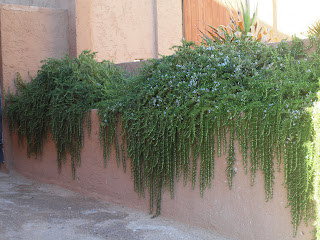Did I hear my local Meteorologist right tonight on the evening news? It’s going to be ninety five degrees within the next few days. If this is true—summer is already here! What happened to spring? Regardless, this will be a real treat after an unusually cool spring here in the Sonoran Desert. The warm weather is inviting and will be a perfect time to clean and prepare the herb garden for the upcoming months. Among the many herbs up for inspection in my garden is the hardy Thyme.
Thyme, Thymus vulgaris also known as Garden Thyme or Wild Thyme is a member of the mint family. Thyme is an annual, perennial and herb that blooms in early summer with small fragrant purple, pink or white flowers. Presently, there are over one hundred types of thyme around the world. Three of the most popular varieties are the Garden, Lemon and Wild Thyme.
 |
| Variegated and Narrow Leaf Thyme |
Ways to distinguish the common varieties are by their leaves, which are either narrow or broad leaved, or variegated. Thyme is used throughout the Sonoran Desert as ground cover and grows well in containers. It is also used decoratively for its cascading abilities to creep along walls and throughout rock gardens. Imagine growing some Creeping Thyme or having some Wild Thyme in your own garden.
I grow my Thyme in a large decorative clay pot, which I keep elevated on a plant stand. The stand holds the oversized pot fourteen inches off the ground and keeps the annoying, but cute desert rabbits from getting into my prized possession. This hardy leafy plant grows at its best in loamy, well drained and neutral soil conditions. My Thyme gets full sun with almost no shade and perseveres in the warm desert weather. Although, thyme is known more for its culinary appeal, it has a variety of medicinal properties that just may surprise you.
In the Kitchen…
Thyme gives off a pungent, bitter and warm flavor when used in: soups, gumbos, chicken, vegetables, jams and stews. For other uses, it can be made into tea, tinctures and oils, or dried in capsules. It has also been found to aid in the digestion of high fat foods.
Additional Uses for…
Thyme are found in its medicinal properties such as: antibacterial, antifungal, astringent, sedative, tonic and diuretics. It also stimulates the lungs by relieving congestion, and rejuvenates and boosts the immune system. Thyme can be used as a topical for conditions such as: arthritis, insect bites and stings. Herbalists suggest using Thyme as a bath herb for sore muscles or add to homemade soaps and massage oils.
Prune…
Thyme when the stems appear to be spiny and lacking their leaves.
If slightly out of shape, then prune lightly.
Prune in late summer after the bloom, or in the fall after the first frost.
More Fun Thymes
Hi Ho Silver Thyme, Moonlight Thyme, Winter Thyme, Passion Pink Thyme, Lime Thyme, French Thyme, English Thyme, Silver Thyme, Tuffet Thyme, Common Thyme, Orange Thyme, Lemon Thyme, and Wild Thyme.
See Sources Tab for References
